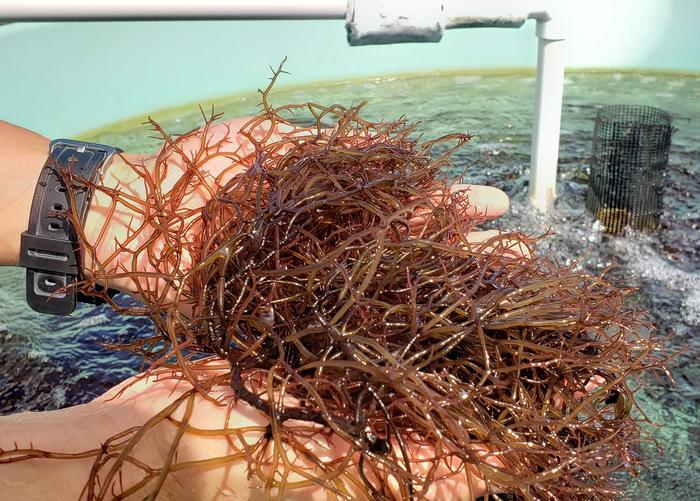From sushi to soups, seaweed is a popular food around the world because it adds delicious flavors and beneficial nutrients to dishes. However, it might also expose consumers to heavy metals that accumulate in the fronds before they’re harvested. Given seaweed’s importance in the Hawaiian islands, a recent ACS Food Science & Technology publication reports a comprehensive analysis of essential nutrients and heavy metals for six species of seaweeds collected around Hawaii.

Credit: Adapted from ACS Food Science and Technology 2024, DOI: 10.1021/acsfoodscitech.3c00476
From sushi to soups, seaweed is a popular food around the world because it adds delicious flavors and beneficial nutrients to dishes. However, it might also expose consumers to heavy metals that accumulate in the fronds before they’re harvested. Given seaweed’s importance in the Hawaiian islands, a recent ACS Food Science & Technology publication reports a comprehensive analysis of essential nutrients and heavy metals for six species of seaweeds collected around Hawaii.
Seaweeds accumulate elements from the environment they’re grown in. Scientists know that factors such as the species or growing conditions impact the essential minerals, nutrients, and nonessential or toxic heavy metals in a serving of seaweed. However, not much is known about the balance of helpful versus potentially harmful compounds in many of the varieties traditionally eaten in Hawaii. Furthermore, the U.S. has not established safe regulatory limits for toxic substances such as arsenic and lead in whole pieces of edible seaweed, meaning that some products available for sale may not be tested for these compounds. So, Kacie Ho and colleagues decided to analyze key nutrients and metals in seaweed species grown around Hawaii.
The researchers obtained six types of seaweed that were either cultivated or collected in the wild. They measured the beneficial nutrients and toxic elements in each species and used statistics to differentiate between samples. They found that:
- Four of the six tested seaweeds were excellent sources of at least one essential mineral — with greater than 20% of the recommended daily value per serving of either iron, manganese, or both calcium and magnesium.
- The amounts of protein, fat, carbohydrates and fiber varied significantly across the tested species, and generally aligned with previous nutritional assessments for three of the seaweeds.
- Two wild species that are not commonly consumed, S. aquifolium and S. echinocarpum, had the highest levels of arsenic-containing compounds — far exceeding safe consumption limits established by other countries.
- Two farmed species, H. formosa and G. parvispora, contained elevated lead levels, which are above those recommended for safe eating in Taiwan.
Overall, the researchers found that Hawaiian seaweeds provide many essential minerals and nutrients, but may also expose consumers to unsafe levels of heavy metals, depending on factors such as seaweed type and growing conditions. Previously published studies suggested that boiling or rinsing other seaweed species, which weren’t included in this work, could remove some harmful substances. But these techniques may also strip away beneficial nutrients. So, Ho and colleagues are collaborating with seaweed growers to study the impact of growing location and common cooking practices on levels of heavy metals and nutrients in Hawaiian seaweeds. Their findings could inform future regulations and ensure nutritious and safe seaweed food products.
The authors acknowledge funding from the United States Department of Agriculture’s National Institute of Food and Agriculture, Multistate Project.
###
The American Chemical Society (ACS) is a nonprofit organization chartered by the U.S. Congress. ACS’ mission is to advance the broader chemistry enterprise and its practitioners for the benefit of Earth and all its people. The Society is a global leader in promoting excellence in science education and providing access to chemistry-related information and research through its multiple research solutions, peer-reviewed journals, scientific conferences, eBooks and weekly news periodical Chemical & Engineering News. ACS journals are among the most cited, most trusted and most read within the scientific literature; however, ACS itself does not conduct chemical research. As a leader in scientific information solutions, its CAS division partners with global innovators to accelerate breakthroughs by curating, connecting and analyzing the world’s scientific knowledge. ACS’ main offices are in Washington, D.C., and Columbus, Ohio.
To automatically receive news releases from the American Chemical Society, contact [email protected].
Note: ACS does not conduct research, but publishes and publicizes peer-reviewed scientific studies.
Follow us: X, formerly Twitter | Facebook | LinkedIn | Instagram
Journal
ACS Food Science & Technology
DOI
10.1021/acsfoodscitech.3c00476
Article Title
Determination of the Nutrient and Toxic Element Content of Wild-Collected and Cultivated Seaweeds from Hawai‘i
Article Publication Date
29-Feb-2024




